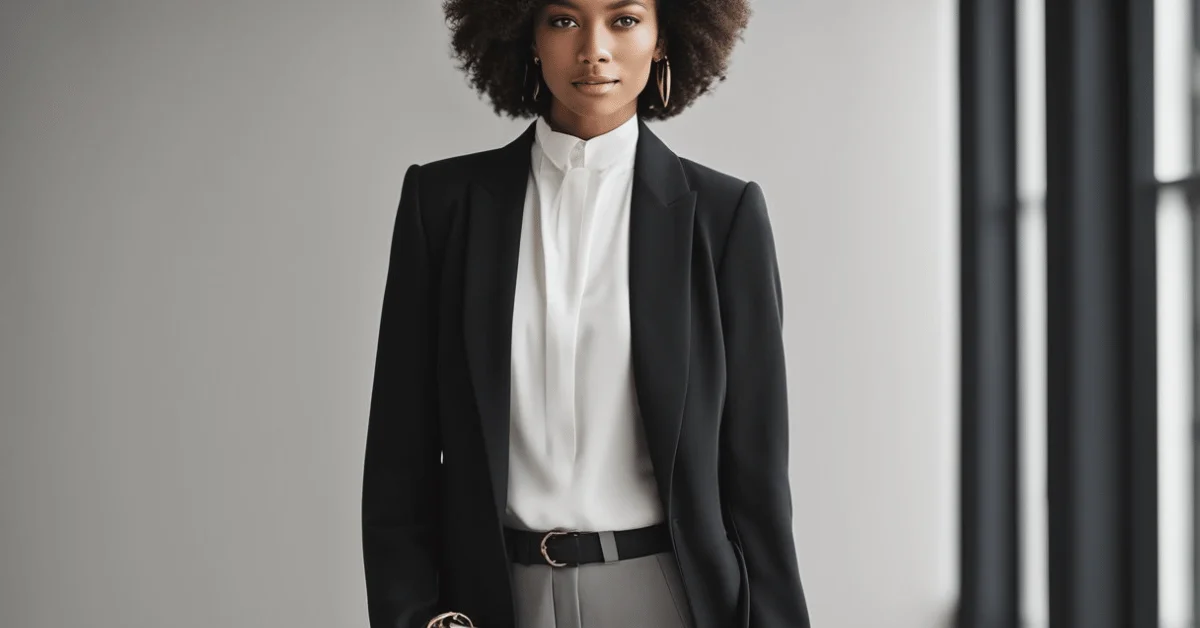Minimalist fashion is a concept that prioritizes simplicity and focuses on the essentials of clothing design.
By selecting pieces that are both timeless and versatile, this approach to dressing allows for a wardrobe that is both coherent and functional. The minimalist aesthetic is characterized by clean lines, monochromatic palettes, and a lack of excessive detailing, favoring quality over quantity and investing in well-made, sustainable garments.
Building a minimalist wardrobe involves curating a collection of items that serve multiple purposes and can be easily mixed and matched. This not only creates a cohesive look but also streamlines the decision-making process each morning.
It is not about having fewer items for the sake of it but about having the right items that can be worn in a variety of contexts.
The goal is to find personal style within minimalism, uncluttered by transient trends, thus establishing a strong sense of self in one’s attire.
Key Takeaways
- Minimalist fashion emphasizes simplicity, functionality, and timelessness in clothing.
- A minimalist wardrobe consists of versatile, intermixable pieces that reflect personal style.
- Embracing minimalism in fashion can lead to more sustainable consumer habits.
The Essence of Minimalist Fashion
Defining Minimalist Fashion
Minimalist fashion is built on the foundation of reducing a wardrobe to its essentials. Distinct characteristics include:
- Monochromatic color palettes
- Simple, clean lines
- High-quality fabrics
- Versatile pieces that can be mixed and matched
It’s not about having fewer items, but rather about each piece being carefully chosen for its utility and aesthetic appeal.
History and Philosophy
The minimalist fashion movement parallels the minimalist art movement that emerged in the 1960s. Its philosophy centers on the idea that beauty and functionality can coexist in simple forms. Key developments include:
- 1960s: Minimalist art inspires fashion with its clean lines and neutral colors.
- 1990s: A resurgence of minimalism in fashion is led by designers like Jil Sander and Calvin Klein.
- Modern Day: It evolves into a lifestyle choice, reflecting a conscious decision to prioritize sustainability and quality over quantity.
Minimalism vs. Fast Fashion
Minimalist fashion starkly contrasts with fast fashion, focusing on sustainability and enduring style versus quick trends and mass production. Consider the following differences:
| Minimalist Fashion | Fast Fashion |
|---|---|
| Emphasizes investment in quality pieces | Produces inexpensive, trend-driven items |
| Encourages a timeless, season-transcending wardrobe | Cycles out products quickly to match trends |
| Aims to reduce waste and promote conscious consumption | Often leads to excessive consumption and waste |
By adopting minimalism in fashion, we champion enduring style, deliberate consumption, and a more sustainable lifestyle.
Building a Minimalist Wardrobe
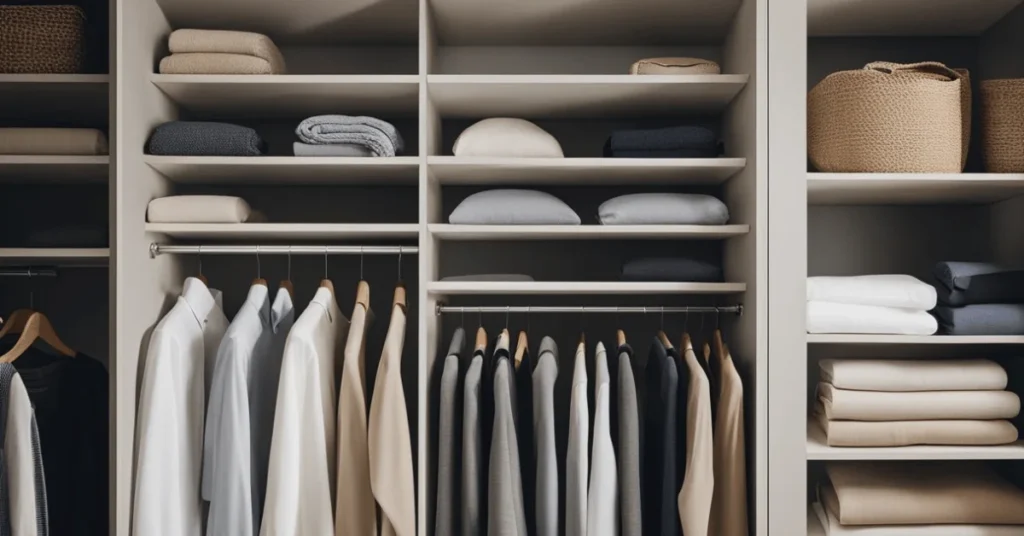
In our journey to fashion minimalism, we focus on the core principles of the capsule wardrobe, the importance of prioritizing quality, and the key pieces that form the foundation of a minimalist closet.
The Capsule Wardrobe Concept
The capsule wardrobe is a compact, streamlined collection of clothing that can be mixed and matched to create multiple outfits. We typically include versatile pieces that transcend seasons and trends. The goal is to maximize the number of outfits we can create from a minimal number of items. For example, a well-curated capsule wardrobe might contain the following:
- Tops: Cotton white button-down, silk black turtleneck.
- Bottoms: Tailored trousers in black or grey, classic blue jeans.
- Outerwear: Cashmere knit sweater, versatile neutral blazer.
- Shoes: Black leather boots, comfortable and stylish flats.
Choosing Quality over Quantity
We prefer high-quality materials such as leather, suede, cotton, cashmere, and silk. These materials not only last longer but also often feel better against the skin and maintain their appearance over time. An investment in quality pieces reduces the need to constantly replace items, thus adhering to minimalist principles. Here’s how we choose:
- Material Check: Opt for natural fibers and well-constructed items.
- Craftsmanship: Look for solid stitching and finishes.
- Brand Ethics: Consider the sustainability and ethics of the brands we buy from.
Essential Items for a Minimalist Closet
Our minimalist closet houses timeless pieces that serve as the foundation for our everyday look. These are the basics we can always rely on:
- Neutral Tones: A selection of tops and bottoms in neutral colors such as black, white, beige, and grey.
- Classic Tops: The ubiquitous white button-down shirt and the versatile black turtleneck.
- Pants: Blue jeans and tailored trousers in a neutral color offer flexibility and comfort.
- Layering Pieces: Knit sweaters and cardigans in cashmere or cotton provide warmth and style.
- Footwear: We invest in black boots and flats that can transition from casual to formal.
By maintaining a capsule of basics, we ensure our wardrobe is filled with functional, chic, and interchangeable pieces, ready for any occasion.
Styling Minimalist Outfits
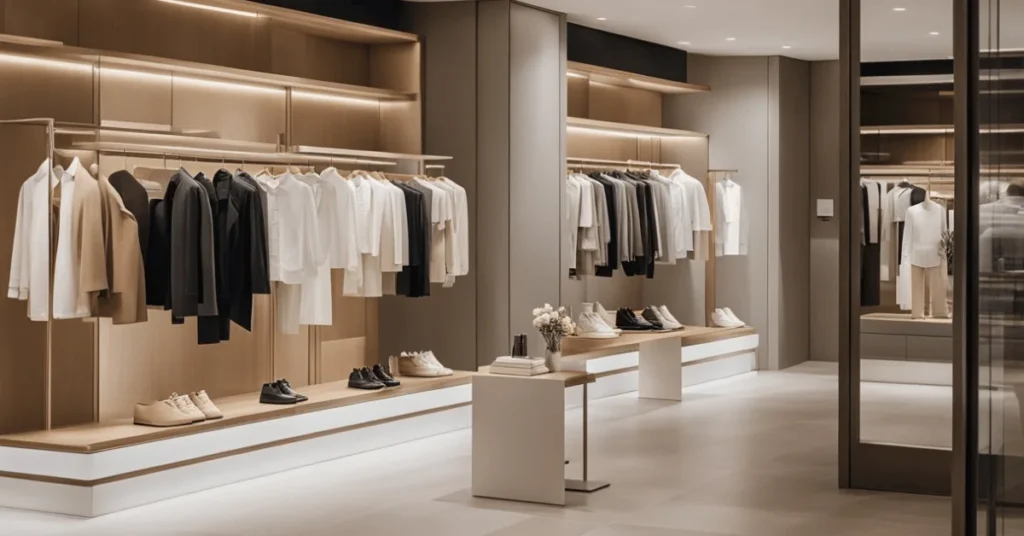
We approach minimalist fashion with the mindset that less is more. Our focus is on clean lines, functional pieces, and a cohesive aesthetic. This section lays out the essentials in curating outfits that echo minimalist principles, embracing both sophistication and purpose.
Mastering the Art of Simplicity
In minimalist dressing, we prioritize elevated basics that stand well on their own. Our goal is to create a capsule wardrobe consisting of versatile items such as wide-leg trousers, a black blazer, and a knit dress. Each piece should be selected for its functionality, fit, and ability to pair seamlessly with others. This method ensures that every outfit we craft is both chic and effortlessly put-together.
- Staple garments include:
- Timeless trench coats
- Monochromatic jumpsuits
- Crisp white co (collared shirts)
Accessorizing with Purpose
We believe accessories should serve an intentional role rather than simply being ornamental. A well-chosen belt, for example, can define the waist and enhance a silhouette, while loafers from brands like neous offer a polished finish without compromising comfort. Strappy sandals add a delicate touch to our look, ensuring that even with limited elements, our style remains complete.
- Select accessories carefully:
- Belts: to sculpt and define
- Shoes: comfortable yet neous-inspired
- Minimalist watches: to blend function and fashion
The Role of Color in Minimalist Fashion
In our color palette, we use hues to create a unified and aesthetically pleasing look. We often employ a monochromatic scheme for a sophisticated feel, using varying shades of a single color to add depth. When we wish to inject personality, a calculated pop of color can make an outfit stand out. However, this is done strategically to ensure that the piece, such as a vibrant accessory or top, accentuates without overwhelming.
- Typical color approach:
- Monochrome: for a cohesive look
- Blacks and greys: for foundational pieces
- Pop of color: to highlight selectively
By adhering to these principles, we assemble minimalist outfits that are both refined and meaningful. We ensure that every element is purposeful and contributes to an overall aesthetic that is intentional and stylish.
Sustainability and Consumerism
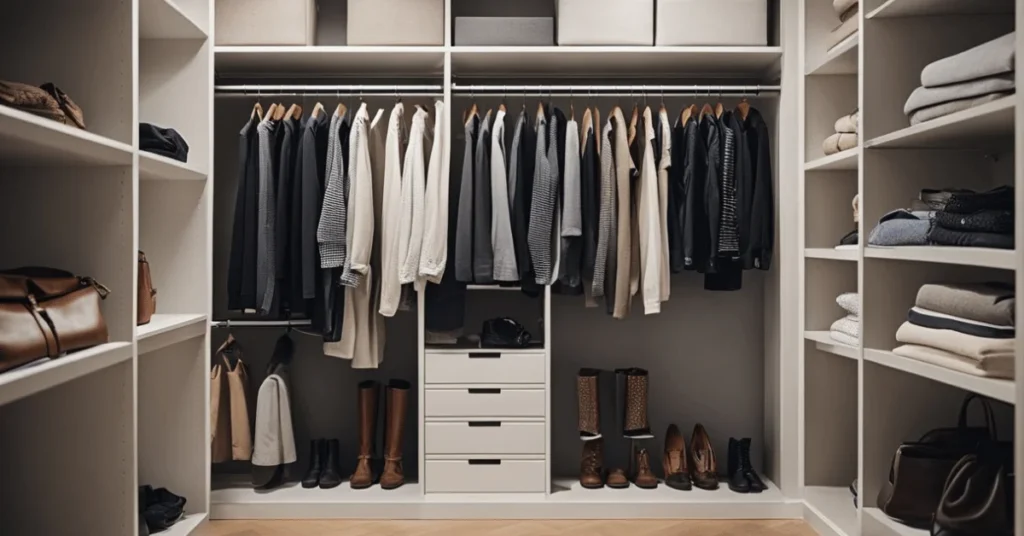
In our contemporary wardrobe choices, the intersection of sustainability and consumerism shapes our environmental footprint. Our fashion habits reflect on the planet’s health, and a shift toward responsible consumerism is crucial.
Impacts of Fast Fashion on the Environment
Fast fashion’s allure lies in its constant influx of affordable trends, yet this comes at a steep environmental price. The industry is a major contributor to water pollution, with textile dyeing being the second largest water polluter. Additionally, it generates substantial amounts of waste as consumers discard clothes after only a few wears.
Key Facts:
- Water Pollution: The fashion industry is responsible for about 20% of global wastewater.
- Waste: An estimated 85% of textiles go to the dump each year in the United States alone.
Embracing Slow Fashion
Slow fashion converges with sustainable life choices, encouraging us to reduce consumption and invest in quality over quantity. Sustainable fashion, part of the broader slow fashion movement, focuses on ethical production methods, fair labor practices, and the creation of long-lasting garments.
Steps to Embrace:
- Prioritize Quality: Select durable clothing that withstands multiple washes and trends.
- Check Practices: Support brands that are transparent about their manufacturing processes.
Sustainable Life Choices
Sustainable life choices encompass decluttering our spaces responsibly and extending the life cycle of our apparel. We can recycle, donate, or sell garments instead of discarding them. Inspired by Marie Kondo’s philosophy, we seek items that “spark joy” and discard those that don’t in an eco-friendly manner.
Responsible Decluttering:
- Recycle: Repurpose old clothing into cleaning rags or art supplies.
- Donate/Sell: Give well-preserved garments a second life by donating or selling them online or to thrift shops.
By incorporating these practices into our lifestyles, we contribute to a greener planet and promote a sustainable fashion industry.
Creating Your Personal Style
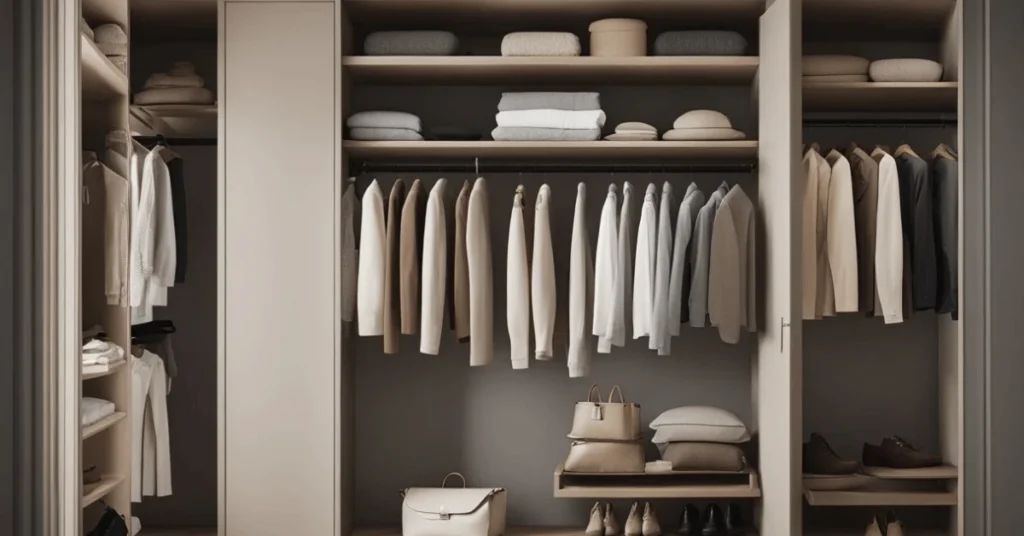
In developing a personal minimalist fashion style, we focus on refining our wardrobe, understanding the psychological perks, and embracing the idea of wearing outfits multiple times.
Decluttering Your Existing Wardrobe
To define our style, we first assess our current clothing. We categorize items into keep, donate, or discard. Our goal is to represent sophistication and versatility, favoring pieces like white sneakers, a Burberry trench coat, and other essentials that form a capsule wardrobe. The process is liberating and sets the foundation for a clutter-free closet.
- Keep: Versatile pieces that match our aesthetic, including neutral colors.
- Donate: Items that no longer suit our minimalist vision.
- Discard: Worn-out or damaged clothing that can’t be repurposed.
The Psychological Benefits of Minimalist Fashion
By embracing minimalist fashion, we significantly reduce stress and decision fatigue in our daily life. A carefully curated selection of clothes simplifies the morning routine, allowing us to start the day with clarity and calmness.
- Reduce Stress: A smaller wardrobe offers fewer choices, making getting ready easier.
- Decision Fatigue: With key pieces, we waste less time deciding what to wear.
Being an Outfit Repeater with Pride
Wearing the same outfit multiple times is a statement of our confidence. We take pride in our ability to style versatile pieces like the classic white sneaker or an elegant trench coat from Everlane in different ways. Repeating outfits reflects a commitment to a sustainable, sensible approach to fashion.
- Versatility: Each piece in our wardrobe works for various occasions.
- Sustainability: Repetition is key to a responsible, eco-friendly wardrobe.
Minimalist Fashion Brands and Icons
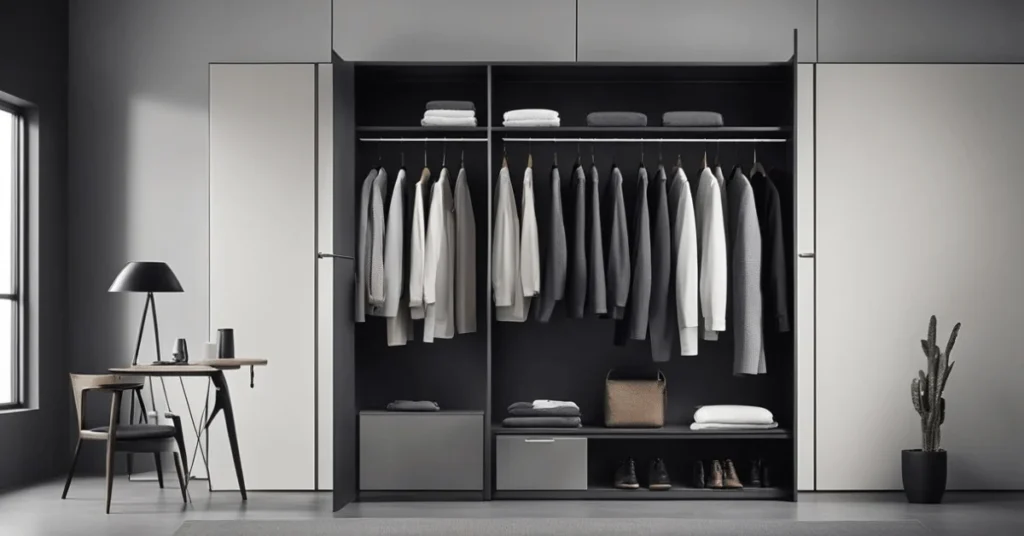
We recognize that minimalist fashion emphasizes simplicity and timelessness. To embody this aesthetic, certain brands and personalities stand out due to their commitment to clean lines, neutral palettes, and quality over quantity.
Brands That Epitomize Minimalist Style
- The Row: Founded by Mary-Kate and Ashley Olsen, The Row offers luxurious minimalism with a focus on tailored silhouettes and a muted color palette.
- Burberry: Although known for its iconic trench coat, Burberry has embraced minimalist luxury with sleek designs under chief creative officers past and present.
- Filippa K: Swedish brand Filippa K creates garments that boast simplicity and sustainability, key tenets of minimalist fashion.
- Lemaire: This brand is synonymous with understated elegance, often featuring oversized and clean-lined clothing.
- Wolford: Specializing in high-quality basics, Wolford provides the perfect building blocks for a minimalist wardrobe.
- The Frankie Shop: Known for its modern and minimalist aesthetic, The Frankie Shop offers chic, pared-back pieces.
- Jil Sander: Often regarded as the queen of minimalism, Jil Sander’s namesake brand is a cornerstone of minimalist style.
- Helmut Lang: Innovator of street-luxe minimalism, Helmut Lang’s designs are characterized by their stark simplicity.
- Calvin Klein: A household name that has long been associated with clean, streamlined designs indicative of American minimalism.
- Everlane: With their transparent approach, Everlane produces modern essentials with a focus on ethical production and lasting design.
- Cuyana: This brand’s philosophy of ‘fewer, better’ epitomizes minimalist fashion with its elegant and practical pieces.
- Frankie Shop: Echoing modern minimalism, Frankie Shop curates essential pieces for the contemporary wardrobe.
Influencers and Icons of Minimalism
Minimalism in fashion isn’t only about the brands; it’s also about the people who embody the style. Icons of minimalism project the aesthetic not just through their clothing choices but also through their lifestyle and the way they influence fashion.
- Phoebe Philo: Former creative director of Céline, Philo is known for her minimalist yet impactful designs that have inspired a cult following.
- Tilda Swinton: An actress known for her androgynous and avant-garde style, Swinton perfectly carries the minimalist aesthetic on and off the screen.
- Steve Jobs: Though not a fashion icon in the traditional sense, Jobs’ signature black turtleneck and jeans became an iconic minimalist uniform.
- Marie Kondo: While known for her decluttering methods, Kondo also applies a minimalist ethos to her personal style, often seen in simple yet elegant attire.
Minimalist fashion is defined by these brands and icons that prioritize design purity, timeless quality, and understated luxury, demonstrating that less can indeed be more.
The Future of Minimalist Fashion
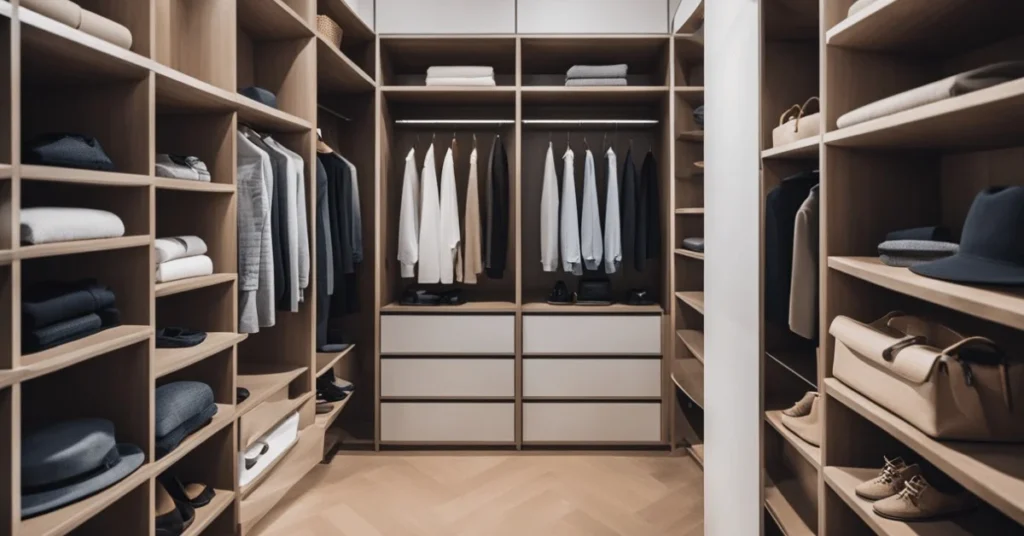
We’ll now focus on the direction minimalist fashion is taking, with particular attention to evolving styles and the impact of cutting-edge technologies.
Trends and Shifts in Minimalist Aesthetics
Shifts in Style: Minimalism is embracing a more dynamic and versatile aesthetic, moving from monochromatic palettes to including bursts of color and varied textures that maintain a sophisticated simplicity. Expect to see fashion lines that are timeless yet adapt to individuality, allowing expression within the minimalist framework.
Fashion’s Timeless Appeal: The concept of “timeless fashion” is strengthening within minimalism. We are seeing a shift towards quality over quantity, with designs that withstand the test of time both in style and durability. Consumers are increasingly choosing pieces that promise longevity—classics that are as stylish now as they will be in a decade.
The Growing Role of Technology
Smart Materials: Our wardrobe is becoming smarter. The integration of technology in fabric production is leading to materials that are not only eco-friendly but also more adaptable and durable. This includes clothes that can change their texture or color based on environmental conditions, and materials that are more resistant to wear and tear.
Technology in Production and Retail: From 3D printing techniques that produce less waste to AI-driven inventory systems that predict demand and reduce overproduction, technology is making minimalist fashion more sustainable and efficient. As we leverage these advancements, our shopping experiences are becoming more personalized, while the fashion industry’s footprint is scaled back.
Frequently Asked Questions
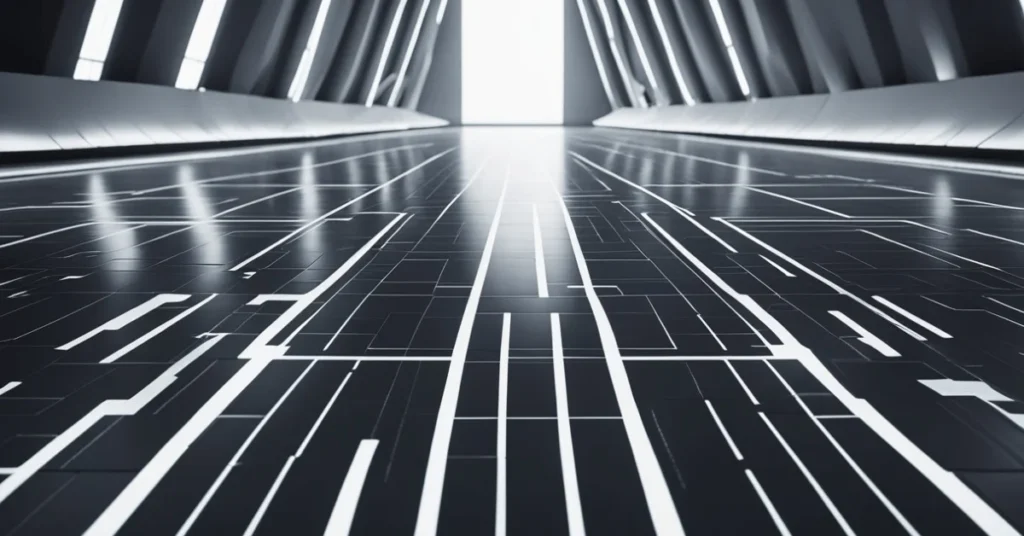
How can one incorporate minimalist principles into their wardrobe?
We focus on purchasing versatile pieces that can be mixed and matched to create multiple outfits. By choosing clothing in neutral colors and simple, clean-cut designs, we build a cohesive and timeless wardrobe that eschews short-lived trends.
Which designers are known for their minimalist fashion collections?
Designers like Jil Sander, Calvin Klein, and Céline have garnered acclaim for their minimalist aesthetic. Their collections often feature monochromatic palettes, streamlined silhouettes, and a strong emphasis on form and function.
What are the characteristics of a classic minimalist style in clothing?
Classic minimalist style is defined by a limited color palette, often consisting of black, white, and gray. Outfits are uncomplicated with a focus on quality materials and fine craftsmanship, ensuring longevity in both durability and style. Silhouettes tend to be sleek and geometric.
In what ways has minimalist fashion evolved throughout history?
Minimalist fashion traces back to various movements, including the Mod style of the 1960s and the streamlined looks of the 1990s. We’ve seen an emphasis on sustainability and material innovation in recent years, with minimalist principles adapting to accommodate eco-conscious consumers.
How does minimalist fashion differ for men and women?
While minimalist fashion principles such as neutral color palettes and simple designs apply to both genders, we observe subtle variances in cut and proportion. For women, the minimalist approach often includes fluid lines and softer silhouettes, whereas men’s minimalist fashion tends toward sharp tailoring and structured forms.
What should be considered when choosing minimalist style furniture?
We prioritize functionality and simplicity when selecting minimalist furniture. The designs are typically straightforward, without ornate details, focusing on the quality of materials and the fine balance between form and utility. Furniture pieces often serve multiple purposes to maximize space efficiency.
We’ve explored the world of ‘Minimalist Fashion,’ but we’re eager to hear from you!
Do you have personal style tips or unique minimalist wardrobe essentials? Share your thoughts and join the conversation in the comments below!

